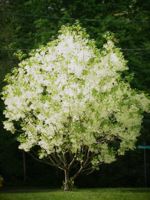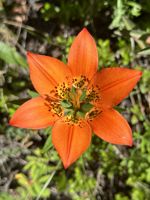Mon-Fri 9am - 5pm Mountain time
White Fringe Tree vs Wood Lily
Chionanthus virginicus
Lilium philadelphicum
NOT AVAILABLE THIS SEASON - MIGHT RETURN
CUSTOM GROW
White Fringe Tree is known for its fringe-like white flowers. It can either grow as a small tree or a large multistemmed shrub. The White Fringe Tree has separate male and female plants. Both male and female flowers have white fringe-like petals, but the male flowers are longer and showier. The female flowers give way to clusters of dark blue to black berries. These berries are not edible for humans but attract birds and other wildlife.
The White Fringe Tree is tolerant of clay soils, saline soils, and air pollution but does not do well in prolonged dry conditions.
Wood Lily is a native perennial wildflower known for its vibrant, trumpet-shaped blooms in shades of orange to red. Its showy flowers appear mid-summer and are highly visible in meadows and prairies. The upward-facing flowers are an important nectar source for many pollinators, including native bees, butterflies, and hummingbirds.
Unlike most lilies, the Wood Lily’s flowers face upward rather than nodding. It is slow to establish and may take years before flowering, but once mature, it requires little maintenance. It is well-suited for pollinator gardens, naturalisation projects, prairie restoration, and open woodland plantings.
Wood Lily is the provincial flower of Saskatchewan and North America’s most widespread lily. Despite its wide natural range, populations have been declining. Habitat loss, overgrazing by deer, and unsustainable picking have reduced both its abundance and density across many regions. These pressures highlight the importance of protecting and restoring this once-common wildflower.
White Fringe Tree Quick Facts
Wood Lily Quick Facts
Toxicity: toxic to cats

